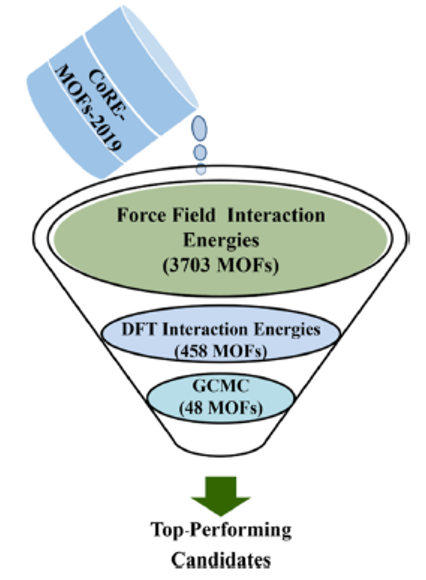Database Screening for CO2 Capture
Stabilizing the escalating CO2 levels in the atmosphere is a grand challenge in view of the increasing global demand for energy, the majority of which currently comes from the burning of fossil fuels. Capturing CO2 from point source emissions using solid adsorbents may play a part in meeting this challenge, and metal−organic frameworks (MOFs) are considered to be a promising class of materials for this purpose.

Stabilizing the escalating CO2 levels in the atmosphere is a grand challenge in view of the increasing global demand for energy, the majority of which currently comes from the burning of fossil fuels. Capturing CO2 from point source emissions using solid adsorbents may play a part in meeting this challenge, and metal−organic frameworks (MOFs) are considered to be a promising class of materials for this purpose. It is important to consider the co-adsorption of water when designing materials for CO2 capture from post-combustion flue gases. Computational high-throughput screening (HTS) is a powerful tool to identify top-performing candidates for a particular application from a large material database. Using a multi-scale modeling strategy that includes a machine learning model, density functional theory (DFT) calculations, force field (FF) optimization, and grand canonical Monte Carlo (GCMC) simulations, a systematic computational HTS was carried out of the all-solvent-removed version of the computation-ready experimental metal−organic framework (CoRE-MOF-2019) database for selective adsorption of CO2 from a wet flue gas mixture. After initial screening based on the pore diameters, a total of 3703 unique MOFs from the database were considered for screening based on the FF interaction energies of CO2, N2, and H2O molecules with the MOFs. MOFs showing stronger interactions with CO2 compared to that with H2O and N2 were considered for the next level of screening based on the interaction energies calculated from DFT. CO2 -selective MOFs from DFT screening were further screened using two-component (CO2 and N2) and finally three-component (CO2, N2, and H2O) GCMC simulations to predict the CO2 capacity and CO2/N2 selectivity. This screening study identified MOFs that show selective CO2 adsorption under wet flue gas conditions with significant CO2 uptake capacity and CO2 /N2 selectivity in the presence of water vapor. Most of the selective MOFs have either strong p-p confinement or confinement with framework atom charges that are complementary to the CO2 atomic charges. These design rules may allow for the future synthesis of improved materials for CO2 capture.